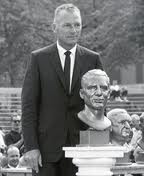Don Hutson
In the era of the one-platoon football, he played as an end and spent his entire 11-year career with the Green Bay Packers.
Under head coach Curly Lambeau, Hutson led the Packers to four NFL Championship Games, winning three in 1936, 1939, and 1944.
Hutson was an eight-time All-Pro selection, a four-time All-Star, and was twice awarded the Joe F. Carr Trophy as the NFL Most Valuable Player.
Hutson was selected to the National Football League 50th Anniversary All-Time Team as one of the greatest players of the NFL's first 50 years in 1969, to the 75th in 1994, and to the 100th in 2019.
As a senior at Pine Bluff High School he was an all-state basketball player, which he said was his favorite sport.
[10] Hutson played at end for coach Frank Thomas's Alabama Crimson Tide football team from 1932 to 1934.
[14] Hutson's College Football Hall of Fame profile reads: "Fluid in motion, wondrously elusive with the fake, inventive in his patterns and magnificently at ease when catching the ball ... Hutson and fellow Hall of Famer Millard "Dixie" Howell became football's most celebrated passing combination.
In an attempt to name retroactive Heisman Trophy winners before its first year of 1936, Hutson was awarded it for 1934 by the National Football Foundation.
[18][19] Georgia Tech coach Bill Alexander once said, "All Don Hutson can do is beat you with clever hands and the most baffling change of pace I've ever seen.
[21] But Green Bay Packers head coach Curly Lambeau saw the speedy Hutson as the perfect receiver for an expanded passing attack, which at the time revolved around the passing of single-wing backs Red Dunn and Arnie Herber to shifty halfback "Johnny Blood" McNally.
"[22] Hutson's first catch as a professional was on an 83-yard touchdown pass from Herber on the first play from scrimmage against the Chicago Bears, in the second game of the 1935 season.
[25] The 1936 season brought the Packers their fourth league title, with a 21–6 win over the Boston Redskins in the 1936 NFL Championship Game.
[2] In 1938, Hutson had nine touchdown receptions, again setting the league record, as he led the Packers to another NFL Championship Game, this time against the New York Giants.
[30] He entered as a substitute three separate times late in the game but was unable to be a factor, catching no passes as Green Bay was defeated 23–17.
"Also considered were his nuisance value as a disrupter of enemy defenses and his ability to transform the Packers into a confident, powerful aggregation in clutch situations.
[39] He changed his mind and returned for the 1943 season,[40] however, and caught 47 passes for 776 yards and eleven touchdowns, leading the league in all three.
After the season Hutson again announced his intention to retire as a player, this time to be an assistant coach for the Packers.
A sportswriter for The Pittsburgh Press jokingly declared Hutson "holder of the world's record for coming out of retirement.
"[44] In a week three, 57–21 blowout win against the Detroit Lions, Hutson set an NFL record with four touchdown receptions in a game, all of them coming in the second quarter.
"[9] While both were students at Alabama, he partnered with Bear Bryant to operate a laundromat in Tuscaloosa called Captain Kidd Cleaners.
[50] While in Green Bay, Hutson opened the Packer Playdium bowling alley,[51] which proved so successful that he twice considered retirement from football to fully dedicate his time to its operation.
[40] He then started the Hutson Motor Car Co. dealership and in 1951 purchased Chevrolet and Cadillac agencies in Racine, Wisconsin.
[53] After he retired from the dealership business, Hutson settled in Rancho Mirage, California, where he lived until his death on June 26, 1997, at the age of 84.
His college career made him a unanimous choice for the Associated Press Southeast Area All-Time football team 1920–1969 era.
[59] Hutson is a member of the Green Bay Packers Hall of Fame, inducted in 1972 along with his quarterbacks, Arnie Herber and Cecil Isbell.
The jersey was found in a trunk of old uniforms in 1946 at the Rockwood Lodge, the Packers' summer training camp from 1946 to 1949, owned by Melvin and Helen Flagstad.
The jersey, a rare NFL artifact valued at over $17,000, was donated by son Daniel Flagstad in memory of his parents.
[64] Hutson's most productive seasons were from 1942 to 1945, a time in which the NFL was severely depleted with many of its most talented players and prospective college athletes serving in the military during World War II.
[9] On the notion that Hutson exploited watered-down defenses, former Packers Hall of Fame running back Paul Hornung responded as such: "I'm a believer.




